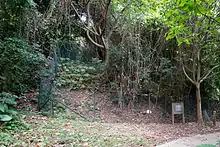Wun Yiu Village
Wun Yiu Village is a village located in Tai Po in Hong Kong. Wun Yiu Village consists of Sheung Wun Yiu (上碗窰) and Ha Wun Yiu (下碗窰).[1]

| Wun Yiu Village | |||||||||
|---|---|---|---|---|---|---|---|---|---|
| Traditional Chinese | 碗窰村 | ||||||||
| Literal meaning | Bowl kiln village | ||||||||
| |||||||||
History
The area was once a center of porcelain industry in the New Territories.
The clans of Man and Tse began manufacturing blue and white porcelain in the Ming dynasty (1368-1644).
In 1674 (the 13th year of the reign of the Qing dynasty Kangxi Emperor), the Ma Hakka clan, originally from Changle county, Guangdong, settled in Tai Po and purchased the kilns from the Man clan.[2]
Because of the competition from good-quality and inexpensive porcelain produced by other coastal kilns in Guangdong, the kilns at Wun Yiu finally stopped operating in 1932.
Declared Monuments
Wun Yiu Pottery Kilns

The remains of the ancient kilns of Wun Yiu Village have been declared a monument.
In the remains of the ancient kilns, relics illustrating the complete process of porcelain production were discovered during archaeological investigations.[2] These artefacts include china clay quarrying pits, water-mills, animal-driven grinders, clay soaking tanks and dragon kilns.[3]
Fan Sin Temple

Fan Sin Temple, alias "Fan Sin Kung" or "Fan Sin Miu", was declared a monument on 30 December 1999.
Fan Sin Temple, located in Sheung Wun Yiu, is the main temple in the villages of the Sheung Wun Yiu and Ha Wun Yiu; it is the only example of worshipping this deity in Hong Kong.
It is uncertain when the temple was constructed. However, according to a wooden plaque hanging at the main hall of the temple, it has a history of over 200 years as the plaque was carved in the geng-xu year of the Qianlong Emperor (1790). It is commonly believed that the Fan Sin Temple was built by the Ma clan to worship Fan Tai Sin Sze, the patron saint of potters.[3]
Windows with iron frameworks were installed on four sides of the temple after World War II.
Many historic relics of the temple were destroyed after a serious fire in mid 1970s. The calligraphy and paintings above the entrance were repainted during a renovation in 1976 after the fire. There is a wooden plaque from 1970 and four commemorative stone plaques which record the restorations in 1897, 1925, 1964 and 1976 respectively.[3]
A further restoration of the temple has recently been carried out and it is now open to the public.
Wun Yiu Trackway
The Wun Yiu Trackway starts at Sheung Wun Yiu Village. It is about 300 metres (980 ft) long. Workers may have used it to transport kaolin from the upper mines down to the workshop before the kiln stopped operation.[3]
References
External links
| Wikimedia Commons has media related to Sheung Wun Yiu. |